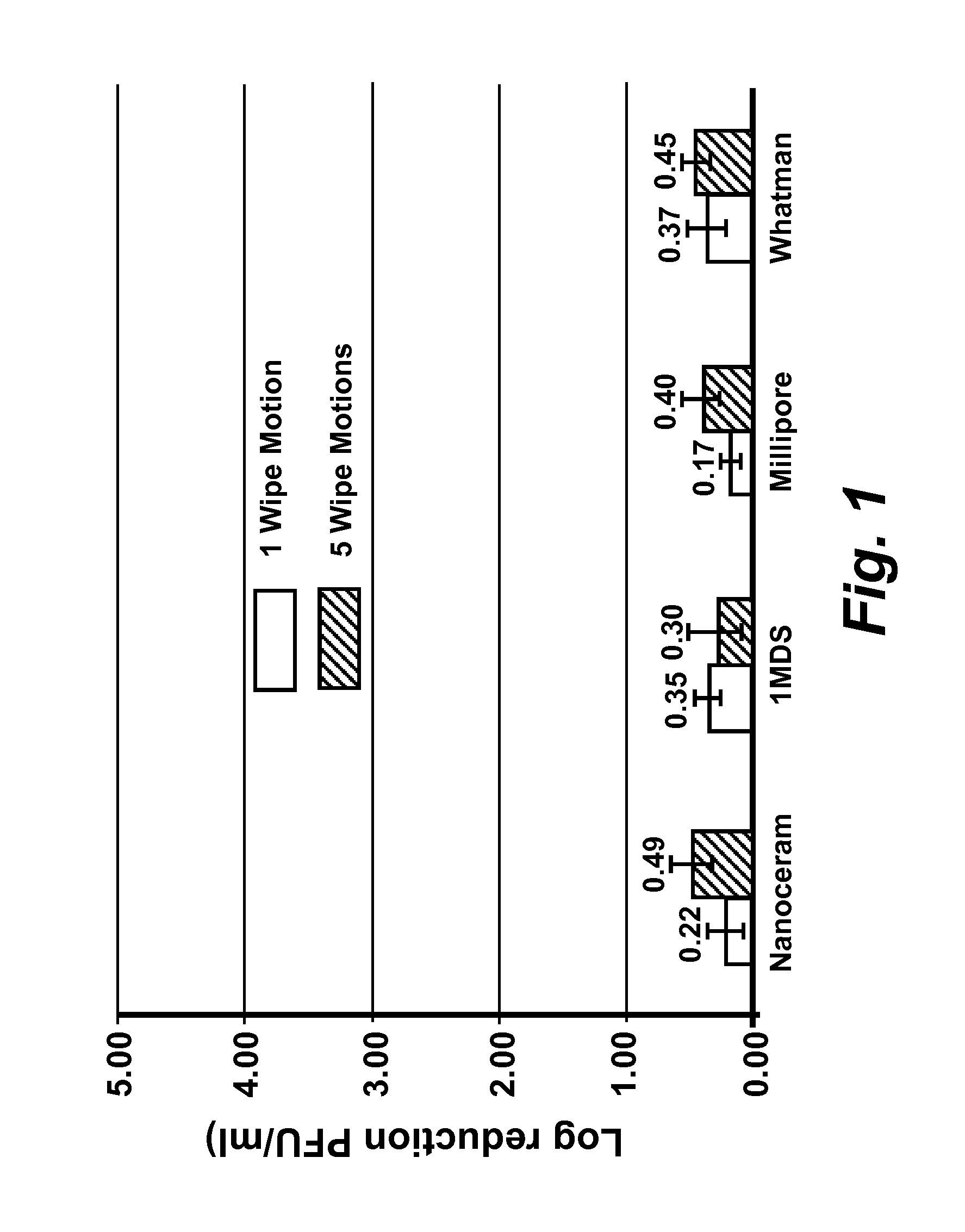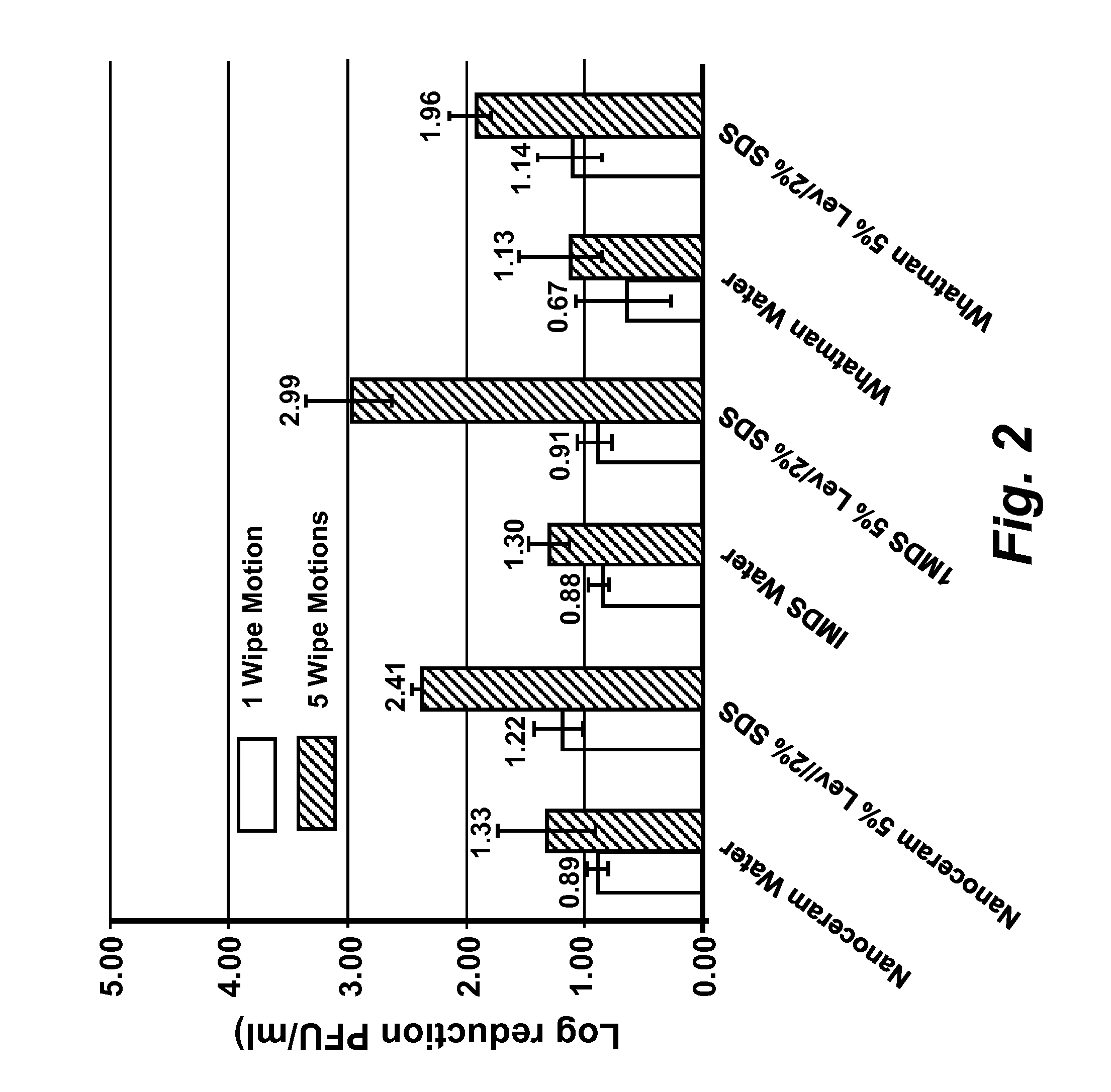Viricidal and microbicidal compositions and uses thereof
a technology of compositions and compositions, applied in the field of microbicidal compositions, can solve the problems of not being able to be used on many surfaces without damage, affecting food safety, and difficult to adequately disinfect non-enveloped viruses from environmental surfaces, etc., and achieve the effect of reducing the viability of a microbial population on the skin surfa
- Summary
- Abstract
- Description
- Claims
- Application Information
AI Technical Summary
Benefits of technology
Problems solved by technology
Method used
Image
Examples
example 1
[0167]Virus cultivation and plaque assay: RAW 264.7 cells (ATCC# TIB-71), Crandell Reese Feline Kidney (CRFK) cells (ATCC# CCL-94) were maintained in either (a) complete Dulbecco's Modified Eagles Medium (DMEM) (Fisher Scientific #SH30081 LS) containing 20% low endotoxin fetal bovine serum (FBS) (HyClone, Logan, Utah) for RAW 264.7 cells, or (b) 20% FBS (Atlanta Biological, GA) for CRFK cells. HeLa-Ohio cells were maintained in complete Modified Eagles Medium (MEM) (Fisher scientific #SH30024LS) containing 20% fetal bovine serum (FBS). RAW 264-7 DMEM was supplemented with penicillin (100 μml), streptomycin (100 μg / ml) with 100 mM HEPES, and 1 mM sodium pyruvate, CRFK DMEM was supplemented with penicillin (100 U / ml), streptomycin (100 μg / ml), 1% L-glutamine and 1% non-essential amino acids. Complete MEM for HeLa-Ohio cells was supplemented with penicillin (100 U / ml), streptomycin (100 μg / ml), 1 mM sodium pyruvate and 1% non-essential amino acids. Murine norovirus (MNV), Feline Calici...
example 2
[0169]Quantification of virus infectivity: To determine the infectious titer of MNV and FCV, standard plaque assay techniques were employed (Cannon et al., (2006) J. Food Prot. 69: 2761-2765, incorporated herein by reference in its entirety). Briefly, cells were dispensed in 60 mm diameter cell culture plates at a density of 2×106 cells per plate and grown to 80-90% confluence in complete DMEM. Immediately preceding infection, the cell culture media was replaced with 0.5 ml of complete MEM without phenol red (Cellgro, Mediatech, Inc, Manassas, Va.), supplemented with either (a) 5% low endotoxin FBS, penicillin (100 U / ml), and streptomycin (100 μg / ml) with 100 mM HEPES, and 10 mM sodium pyruvate for MNV or (b) 4% FBS, 1% L-glutamine and 1% non-essential amino acids for FCV.
[0170]Ten-fold serial dilutions of virus were prepared in phosphate buffered saline (PBS) pH 7.5 and cell monolayers were infected in duplicate with 0.1 ml of each virus dilution, and 0.5 ml of complete MEM (see be...
example 3
[0172]Determination of MNV, FCV, and HRV-16 inactivation by levulinic acid plus sodium dodecyl sulfate solution: Working concentrations of levulinic acid plus sodium dodecyl sulfate (SDS) (both from Sigma-Aldrich, St. Louis, Mo.) were prepared from 20% or 98% stock solutions by dilution in sterile, ultra-purified, de-ionized water on the day of each experimental trial. Partially purified virus cell culture lysate or concentrated virus cell culture lysate (approximately 3×106 PFU / ml stock; 0.1 ml) was added to each concentration of levulinic acid plus sodium dodecyl sulfate solution (0.9 ml) and mixed on a shaking platform (200 rpm) at 21° C. At each time interval (0 secs, 20 secs, 40 secs, 1 min or 5 min), 0.1 ml of the solution was removed and immediately diluted 1:10 (for all concentrations less than or equal to 2% levulinic acid plus 1% sodium dodecyl sulfate) or 1:1000 (for concentrations greater than 2% levulinic acid plus 1% sodium dodecyl sulfate) in complete DMEM containing ...
PUM
| Property | Measurement | Unit |
|---|---|---|
| pH | aaaaa | aaaaa |
| pH | aaaaa | aaaaa |
| pH | aaaaa | aaaaa |
Abstract
Description
Claims
Application Information
 Login to View More
Login to View More - R&D
- Intellectual Property
- Life Sciences
- Materials
- Tech Scout
- Unparalleled Data Quality
- Higher Quality Content
- 60% Fewer Hallucinations
Browse by: Latest US Patents, China's latest patents, Technical Efficacy Thesaurus, Application Domain, Technology Topic, Popular Technical Reports.
© 2025 PatSnap. All rights reserved.Legal|Privacy policy|Modern Slavery Act Transparency Statement|Sitemap|About US| Contact US: help@patsnap.com



